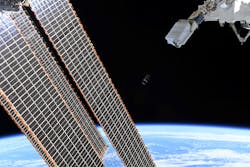SpooQy-1 shows promise of nanosatellites for optical quantum networks
Experiments by China's satellite Micius have shown that quantum signals can reach Earth from satellites with their entanglement intact, pointing the way to building a global quantum internet. Now, an international team led by researchers at the Centre for Quantum Technologies (CQT), National University of Singapore has shown that nanosatellites might do the job, saving costs compared to using larger satellites.1
The team's nanosatellite, called SpooQy-1, weighs just 2.6 kg; in orbit 400 km above the Earth, the satellite has confirmed that it creates entangled quantum signals in a compact instrument onboard. Entanglement is a correlation in the properties of particles that can bring gains in privacy and computing power.
Both SpooQy-1 and Micius carry quantum sources that create pairs of entangled photons. The challenge in building a quantum internet via the more-usual fiber-optic network is that optical losses in fiber limit quantum signals to distances of a few tens of kilometers. Satellites could reach further.
Results from Micius published in Nature on 15 June 2020 showed that the satellite sent entangled signals simultaneously to two ground stations 1120 km apart, creating a secure encryption key at a rate of 0.12 bit/s. Micius weighs 630 kg in total, including a quantum light source weighing 23.8 kg.
Photon pairs produced by spontaneous parametric downconversion
The new SpooQy-1 light source is a polarization-entangled photon-pair source with a 405 nm laser diode pumping beta-barium borate (BBB) crystals, resulting in spontaneous parametric downconversion (SPDC) producing pairs of entangled photons, which are separated by a dichroic beamsplitter so that their polarizations can be separately analyzed. About 1400 photon pairs per second are generated for 17 mW of pump power.
A country the size of Singapore could have a fiber-based quantum network (and in separate Singaporean projects, the Infocomm Media Development Authority, Singtel, and ST Engineering have been looking at this technology), but innovation is needed to go global.
Nanosatellites like SpooQy-1 are cost-effective to build and launch because they follow industry standards for CubeSats and have a small size. SpooQy-1 launched first to the International Space Station (ISS) from the United States in April 2019, and then into orbit with help from the station's astronauts on 17 June 2019. CQT made these arrangements for space travel with the Singapore Space and Technology Association and the Japan Aerospace Exploration Agency.
Before the satellite left Earth, much of the team's work went into miniaturizing the quantum source to fit into SpooQy-1's shoe-box-sized frame, optimizing it to work with minimal power, and making it rugged enough to survive a rocket launch and conditions in space.
“At each stage of development, we were actively conscious of the budgets for mass, size and power,” says Aitor Villar, one of the researchers. “By iterating the design through rapid prototyping and testing, we arrived at a robust, small-form factor package for all the off-shelf components needed for an entangled photon-pair source.” Trials of earlier prototype instruments were carried out by flying equipment on a weather balloon to the edge of the atmosphere and in another NUS-built nanosatellite called Galassia.
The satellite has now been operational for a full year, completing about 5800 orbits around the Earth, and continues to function well.
SpooQy-1 is controlled from ground stations in Singapore and Switzerland, but it hasn’t attempted to send its quantum signals to Earth. That’s the goal of a next phase, announced in 2018 as a joint project between Singapore and the UK.
For that mission, researchers at CQT are collaborating with RAL Space in the UK to design and build a quantum nanosatellite similar to SpooQy-1 with the capabilities needed to beam entangled photons from space to a ground receiver. Some of this work is happening with SpeQtral, a venture-funded startup that spun off from CQT to commercialize satellite-based quantum communication systems. This next quantum nanosatellite is slated for launch in 2022.
Source: https://www.quantumlah.org/about/highlight/2020-06-spooqy-quantum-satellite
REFERENCE:
1. A. Villar et al., Optica, 7, 7, 734-737 (2020); doi: https://doi.org/10.1364/optica.387306.
About the Author
John Wallace
Senior Technical Editor (1998-2022)
John Wallace was with Laser Focus World for nearly 25 years, retiring in late June 2022. He obtained a bachelor's degree in mechanical engineering and physics at Rutgers University and a master's in optical engineering at the University of Rochester. Before becoming an editor, John worked as an engineer at RCA, Exxon, Eastman Kodak, and GCA Corporation.

